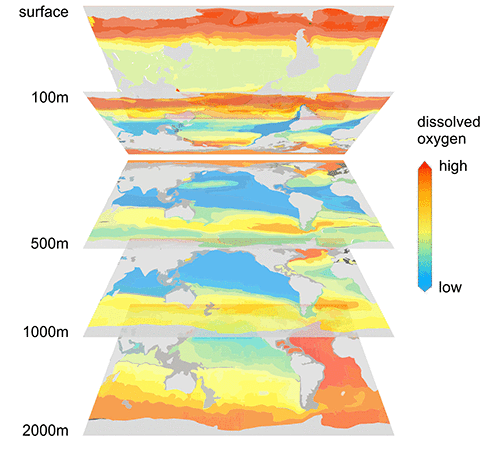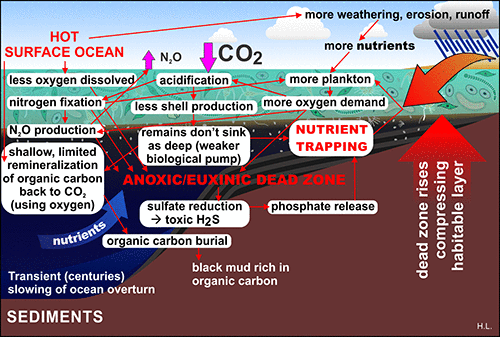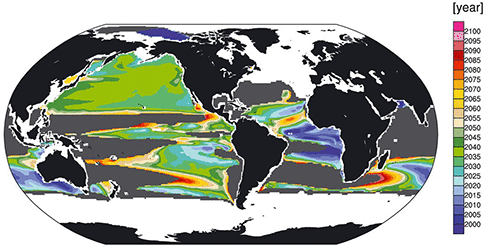
Ocean anoxia – widespread oxygen-starved dead zones in oceans - did the killing of ocean life in several mass extinctions of Earth’s past. Anoxia went hand-in-hand with CO2 emissions, rising global temperatures, and (often) ocean acidification, a situation which today’s climate change is recreating with uncanny likeness.
Atmospheric oxygen levels are declining as a result of burning fossil fuels, but that’s not the cause of ocean anoxia. Neither are we at risk from asphyxiation, because the oxygen decline is at a rate of about 4 parts per million (ppm) per year, compared to an atmospheric oxygen concentration of 21% (ie 210,000 ppm). It would take nearly 4,000 years of burning fossil fuels at current rates before atmospheric oxygen declined to unsafe levels!
Even in normal, healthy oceans, dissolved oxygen levels in middle-depth waters (between about 500 to 1,500 meters) are low enough to discourage most higher animals. This makes those depths an important refuge for krill and other prey species to hang out during the day, safe from visual predators. In the dark of night, these creatures venture nearer the surface to graze on plankton, an impressive commute given their small size.

Depth slices through the oceans showing how dissolved oxygen declines from the surface to middle depths and then rises again in deep water. Constructed from World Ocean Atlas 2013.
There are places around the world where these oxygen minimum zones are much shallower than elsewhere, and there are also coasts where polluted river water delivers excess nutrients into the sea, causing coastal dead zones, for example in the Gulf of Mexico. But these pale in comparison to times in Earth’s past when ocean anoxia became so intense and widespread that it contributed to the permanent annihilation of many marine species. But if we look at the conditions that led to past “Ocean Anoxic Events” (OAEs), and compare them to our altered climate in the coming decades, the parallels are sobering.
There is a complex interplay between a warming climate, its effects on land, delivery of nutrients to the ocean, life’s response to the changes, and chemical results. It works mainly by affecting 2 complementary parts of the ocean carbon cycle:
The biological carbon pump is the process that transports carbon from the near-surface of the ocean to deep water. It is the overall effect of sinking fecal matter along with dead, decaying remains of near-surface life, hitchhiking microbes, and a broth of organic molecules. In this way the biological carbon pump takes carbon that was in the atmosphere before it was fixed into organic matter by photosynthesizing plankton, and sequesters it into the deep ocean and seafloor. For more detail on the biological carbon pump see this explainer by Nature Education.
Remineralization uses the carbon in the biological pump as food for myriad lifeforms, chiefly zooplankton and microbes, which convert it back to CO2 through respiration, consuming oxygen and liberating nutrients at the same time. Remineralization therefore works against the carbon pump. The remineralization depth is the depth to which most organic matter sinks before it is consumed and respired, determined by factors like the amount of shelly mineral, how clumped the organic particles are, how big they are, and how soluble they are. It’s not so much a single floor level but a diminishing curve, represented by the depth at which only 37% of the original organic matter remains (0.37≈ 1/e). In modern oceans it is about 590 meters deep.

The complex biogeochemical connections in ocean anoxia. The 3 connected drivers of anoxia include warming (left), acidification (center), and nutrient supply (right). This diagram is schematic, based partially on Gehlen et al in “Ocean Acidification”, OUP 2011, and on others referenced below.

The stronger biological pump and deeper remineralization in a normal, pre-industrial ocean. This diagram is schematic, based partially on Gehlen et al in “Ocean Acidification”, OUP 2011, and on others referenced below.
Remineralization depth feedback to atmospheric CO2
A deep remineralization depth encourages oxygenated deep water and a strong carbon pump. It also increases the concentration of CO2 in deep water compared to shallow waters, so that where those waters eventually well up to the surface, they can cause localized CO2 outgassing back into the atmosphere, rather than absorbing CO2 from the atmosphere. A shallow remineralization depth, on the other hand, encourages oxygen-starved zones in relatively shallow water. It also liberates CO2 near the ocean surface, reducing the ocean’s ability to absorb atmospheric CO2.
During the last ice age the remineralization depth deepened by about 110 meters, reducing atmospheric CO2 by 30 – 77ppm, while modern warming of the oceans does the opposite - it moves the remineralization depth shallower, reducing the oceans’ CO2 absorption capacity, with potentially substantial impacts on atmospheric CO2 levels expected this century.
Different words are used to describe different degrees of deoxygenation: “hypoxic,” “suboxic” and “anoxic” just refer to decreasing levels of dissolved oxygen. “Euxinic” describes waters that are not only anoxic but where sulfate-reducing bacteria are generating toxic hydrogen sulfide (the “rotten egg” gas). As oxygen levels decline, microbes use other chemicals, eg nitrate, to power their anaerobic respiration.
|
Term: |
Hypoxic |
Suboxic |
Anoxic |
Euxinic |
|
Oxygen level: |
< ~60 μmol kg−1 |
<∼5 μmol kg−1, |
<∼1 μmol kg−1, |
<∼1 μmol kg−1, |
|
Respiration: |
dead zone for many higher animals |
Anaerobic: Nitrate reduction |
Anaerobic: Mn, Fe reduction |
Anaerobic: Sulfate reduction and H2S production, Methane oxidation |
Based on Keeling et al 2010 , Gilly et al 2013 , Wright et al 2012
Several of the big global warming events in Earth’s past were also Ocean Anoxic Events, with widespread ocean anoxia coupled to global warming, and, in most cases, ocean acidification – like today.
|
Event |
Associated Large Igneous Province |
Global Warming? |
Marine Anoxia? |
Ocean Acidification? |
Reference |
|
PETM |
North Atlantic |
Y |
some |
Y |
|
|
End-Cretaceous |
Deccan (+ Chicxulub impact) |
Y |
Y |
?Y |
Mizukami et al 2013, De Oca et al 2013, Thibault & Husson 2016 |
|
Coniacian-Santonian (Oceanic Anoxic Event 3: OAE-3) |
? |
Y |
Y |
|
|
|
Cenomanian–Turonian (Oceanic Anoxic Event 2: OAE-2) (a.k.a. “Bonarelli event”) |
Caribbean |
Y |
Y |
?Y |
|
|
Early Albian Oceanic Anoxic Event (OAE1b) |
Kerguelen |
Y |
Y |
?Y |
|
|
Aptian Ocean Anoxic Event (OAE 1a) (a.k.a. “Selli event”) |
Ontong Java |
Y |
Y |
Y |
|
|
Toarcian (Jurassic) |
Karoo-Ferrar |
Y |
Y |
Y |
|
|
End-Triassic |
Central Atlantic |
Y |
Y |
? |
|
|
Carnian (Triassic) |
Wrangellia |
Y |
limited |
Y |
|
|
End-Permian |
Siberian Traps |
Y |
Y |
Y |
|
|
Capitanian (Permian) |
Emeishan |
Y |
Y |
Y |
|
|
Frasnian-Famennian (Devonian) |
Viluy |
Y |
Y |
? |
|
|
End-Ordovician |
(none) |
Warming after intense cooling |
Y |
? |
|
|
Mid-Cambrian |
Kalkarindji |
? |
Y |
? |
In all cases except the Ordovician, it started with rapidly rising CO2 levels (in most cases, if not all, from Large Igneous Province eruptions), which generated global warming. The warmer oceans and atmosphere promoted stronger chemical weathering of rocks, liberating their nutrients into rivers, which delivered them to lakes and oceans. For OAE-2 in the Cretaceous, chemical weathering is calculated to have increased by 300% in response to a 5ºC sea-surface warming.
Warming has a direct effect on deoxygenation because warmer water dissolves less gas, so warming reduces the amount of oxygen dissolved in oceans; but this is not nearly as strong a factor in creating ocean anoxia as the effect of nutrients (see below). Warming exerts a stronger effect by increasing ocean life’s metabolic rates, which typically double for every 10ºC increase in shallow oceans (ie doubling oxygen demand, so using up dissolved oxygen twice as fast). Warming also causes the remineralization depth to rise.
Deep ocean warming alters the population of bacteria and archaea (archaea look like bacteria but have different genetics and biochemistry) that live in deep ocean sediments. As water temperatures rise, the microbe population, especially of archaea, actually declines significantly. Since their habitat covers 65% of the globe, this population decline represents a significant change in the balance between carbon in water and carbon in sediments.
The combined effects of warming are to increase nutrient supply to oceans, raise the remineralization depth, increase the respiration rate, and reduce oxygen solubility – all of which reduce ocean oxygen concentration in progressively shallower waters.
The level of oxygen dissolved in water is overwhelmingly controlled by the supply of nutrients to the food web.
Phytoplankton (plant plankton, algae) and zooplankton (animal plankton) make up over 90% of the mass of marine life and form the base of the food web. If the supply of nutrients (including carbon, phosphate, Iron, nitrogen, etc) increases, it enables them to multiply and bloom. As they multiply, they excrete waste and they support the multiplication of life that feeds on them, which also excrete more waste. Most of that life respires using up oxygen, so as oceans support ever more plankton and microbial life, oxygen levels in shallow water drop substantially.
When Montiero et al (2012) ran models of the Cretaceous OAE-2 event, they were only able increase ocean anoxia by a couple of percent by reduced oxygen solubility alone, but when they added nutrients, the global oceanic oxygen decreased by 70% and the geographic areas of anoxia expanded from 5% to over 50%, matching the observations of the extent of anoxia in the geological record for that time.
Massive nutrient supply even seems to be able to generate anoxia in cold oceans. As the planet emerged from the last ice age, ocean anoxia expanded in the Eastern Pacific. A similar but far more extreme situation seems to have driven the Ordovician mass extinction event, as I explored in this earlier post.
Sluggish ocean circulation used to be thought of as an important factor in anoxic events, but anoxia can occur even in actively circulating oceans. The reason is that upwelling of deep waters returns even more nutrients to the shallow ocean, enabling plankton to bloom, which as we saw above is the main driver of anoxia.
Past OAEs were long-lived affairs, so even though there may have been some thermal stratification of the surface ocean, which would have trapped nutrients and hindered the uptake of oxygen from the atmosphere, this would have been a transient effect, lasting a few centuries as compared to the OAE as a whole which typically lasted a few hundred thousand years. Stratification is a much more important factor in modern climate change.
Accidents of geography can create zones where nutrients are trapped, creating regions that are much more prone to anoxia than other areas. In the Cretaceous, for instance, the North Atlantic was much more restricted than it is now, and so was already prone to anoxia before OAE-2. During OAE-2, anoxic and euxinic waters expanded over a large portion of the oceans, depositing black muds rich in organic matter that are now oily black shales.
In the modern world, the Black Sea and the Gulf of Mexico, as well as some fjords, naturally trap nutrients making them prone to anoxia or euxinia. The Eastern Pacific is another area prone to low-oxygen because old, nutrient-rich waters well up along the coast, leading to large oxygen minimum zones and shoaling of low oxygen waters, causing die-offs and long term reduction in fish stocks.
Deoxygenation and ocean acidification are closely linked. If CO2 levels rise fast enough to decrease the carbonate levels in the ocean, ocean acidification is the result (ie it’s not just about a lowering pH). Low carbonate saturation makes it harder for plankton to make carbonate shells, so they tend to be smaller and thinner, and organisms that make heavier shells may die out. The net effect of this is to reduce the “ballast effect” – it reduces the rate that organic particles sink into the deep levels of the oceans. This traps more nutrients near the surface of the ocean, exacerbating anoxia.
Low oxygen zones are also naturally more acidic due to life respiring food and generating CO2, an effect known as “respiration-driven acidification,” so as low-oxygen waters expand they amplify ocean acidification in affected areas.
Acidification also has a number of biogeochemical effects that promote anoxia. It changes the ratio of carbon to nitrogen, which in turn increases the production of organic carbon, increasing the demand for oxygen. Acidification also enhances nitrogen fixation, which captures nitrogen and converts it into a nutrient, which boosts plankton levels further, increasing shallow-water oxygen demand.
Ammonium waste is oxidized by microbes in low-oxygen environments via a chemical process known as “anammox,” consuming oxygen and generating nitrous oxide (N2O). As low-oxygen environments expand so may the production of nitrous oxide, which is mostly emitted to the atmosphere, where it is a minor greenhouse gas.
Today, deoxygenation from climate change is already exceeding natural variability in the southern Indian Ocean, parts of the eastern tropical Paci?c, and the Atlantic Ocean. Coastal dead zones have spread exponentially since the 1960s, becoming more intense as a result not just of rising ocean temperatures, but also due to excess nutrients in runoff from the land. Low-oxygen, low-carbonate, low pH waters now bathe seabed habitats along the west coast of the Americas and other places such as the Bay of Bengal. Oxygen minimum zones in tropical and sub-tropical oceans have expanded significantly in recent decades, compressing habitats for many fish, and expanding the habitat for low-oxygen-tolerant species such as the Humboldt Squid.

Timeframe when deoxygenation will exceed the natural variability. Blue shades indicate that the human deoxygenation signal is detectable around now, green shades show the spread of deoxygenation expected between now and around 2050 under a business-as-usual scenario. Gray areas have high natural variability, so will need a longer time for the human-caused effects to be formally distinguishable from natural variability. Blank areas are where the parameter used in the model (σθ=26.5 potential density surface) is at the ocean surface. Figure from Long et al (2016).
A significant component of modern deoxygenation is due to ocean stratification – the formation of a warm water ‘lid’ at the ocean surface that resists mixing into deep water. Stratification inhibits the movement of surface oxygen into deeper water, and it also promotes nutrient trapping near the surface. On geological timescales stratification is transient, lasting only a few centuries, so was probably not an important factor in the much longer-lasting OAEs of Earth’s past.
As rainfall becomes more intense and erosive, as ice recedes, and as we clear forests and land cover, the supply of nutrients pouring into the oceans keeps promoting the expansion of low-oxygen zones. Warmer temperatures will keep weathering rates, and therefore nutrient supply to the oceans, higher for centuries. Add-in warming and acidification from rising CO2 levels, and we have the complete list of ingredients to bake our very own Ocean Anoxic Event.
Just as in the Cretaceous OAE-2, where preexisting oxygen minimum zones expanded with global warming, so the Eastern Pacific is expected to suffer the greatest impact on marine biodiversity in the coming decades. Human-caused ocean deoxygenation is expected to become widespread globally by the 2030s or 2040s, and increase substantially through the end of the century if we continue business-as-usual CO2 emissions.
On top of all that, though, there is the positive feedback by deoxygenation onto global warming by a shallower remineralization depth, greater nitrous oxide emissions, and weakening of the organic carbon pump.
Ocean deoxygenation is the 3rd but less-reported member of an evil climate change trinity, along with global warming and ocean acidification. It is not so much another shoe dropping out of our CO2 emissions as it is a large boot kicking ocean ecosystems, with significant knock-on impacts for hundreds of millions of people who depend on the oceans for a living, and with feedbacks on climate. Ocean scientists have been calling for policymakers’ urgent attention on this issue, and the Royal Society will be hosting a conference on the topic at The Royal Society in London in September 2016.
Scripps Institution of Oceanography, Scripps O2 Global Oxygen Measurements (2016), http://scrippso2.ucsd.edu/
World Ocean Atlas 2013, Volume 3: Garcia, H. E., R. A. Locarnini, T. P. Boyer, J. I. Antonov, O.K. Baranova, M.M. Zweng, J.R. Reagan, D.R. Johnson, 2014. World Ocean Atlas 2013, Volume 3: Dissolved Oxygen, Apparent Oxygen Utilization, and Oxygen Saturation. S. Levitus, Ed., A. Mishonov Technical Ed.; NOAA Atlas NESDIS 75, 27 pp.
Posted by howardlee on Wednesday, 18 May, 2016
 |
The Skeptical Science website by Skeptical Science is licensed under a Creative Commons Attribution 3.0 Unported License. |